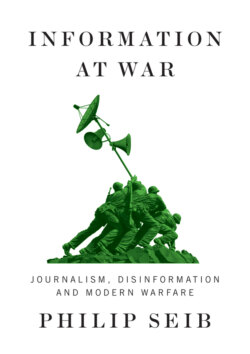Читать книгу Information at War - Philip Seib - Страница 6
Preface and Acknowledgments
ОглавлениеI have been writing about media and war for several decades, focusing mostly on 20th- and early 21st-century conflicts. “Media” in that context meant mostly traditional print and broadcast journalism, and cases such as the Vietnam War and Iraq War provided plenty to write about.
Then came the media explosion: regional and global satellite television channels that could sail above many of the world’s borders, and the internet-based information venues that made obsolete the notion of the “audience” as merely a passive recipient of information. Within the span of a few years, many of the nearly 8 billion people on the planet had access not just to unprecedented quantities of journalism, but also information about health, education, making a living, and other essential topics (with some cat videos added to the mix).
The democratization of the information process has had profound effects. When George Floyd was killed on a Minneapolis street in May 2020, how did we find out about it? A bystander captured the horrific episode on a cellphone camera, and within a short time the video could be seen by much of the world. When Bashar al-Assad murdered his own people with chemical weapons, how did we learn it had happened? Some brave Syrians filmed and described events and posted the information online. Again, the world became a witness.
Information is powerful, and if it is accurate and meaningful, the more the better; the public benefits. But the new information venues also lend themselves to manipulation, including governments’ efforts to destabilize other nations’ political systems. Such weaponization of information requires countermeasures that depend on the public understanding the components of media literacy. Meanwhile, militaries are finding that information can be a valuable supplement to conventional weaponry, making their own efforts more effective and undermining adversaries’ willingness to fight.
These are complex and vital matters. This book is designed to stimulate thinking about the past, present, and future of information at war.
Acknowledgments
Several of my students at the University of Southern California (USC) served as my research assistants during the writing of this book: Adriana Robakowski, Felix Bartos, and Fatime Uruci. They worked hard, and I thank them all. Also at USC, I have consistently been supported by Annenberg School Dean Willow Bay and Journalism School Director Gordon Stables.
Others who helped include another USC student, Christopher Cheshire, who provided some bibliographic material, and an international array who read parts of the manuscript and supplied comments and specialized material: Mariami Khatiashvili, Barbora Maronkova, Di Wu, and Mohamed Zayani. They all have my gratitude.
Polity Books is once again a wonderful partner. Publisher Louise Knight and her assistant Inès Boxman are quick and thorough in all editorial matters, and they are consistently a pleasure to work with. I also thank the two anonymous reviewers whom Polity asked to read my draft manuscript. Their suggestions were most helpful.
Much of my writing took place amidst the Covid-19 pandemic and social isolation. I was buoyed by the friendship of Anita Yagjian. Special thanks to Machiavelli (Mac) Seib, my canine companion and editorial assistant, who helped me retain a bit of sanity by requiring frequent trips outdoors.
